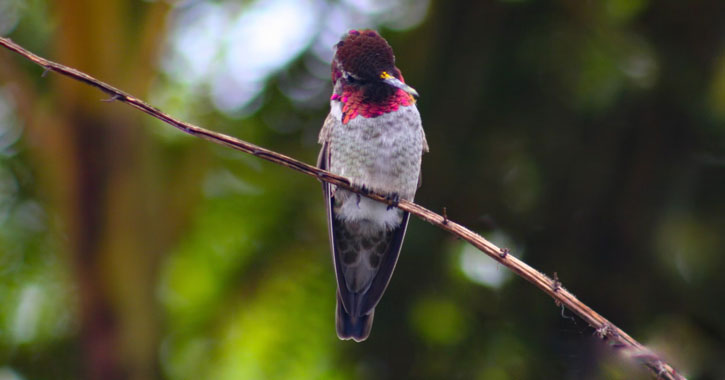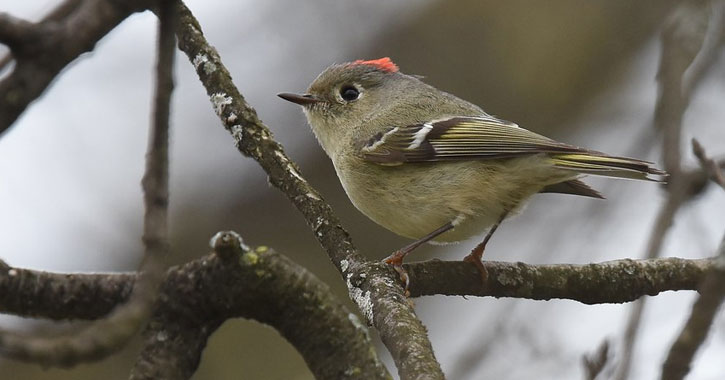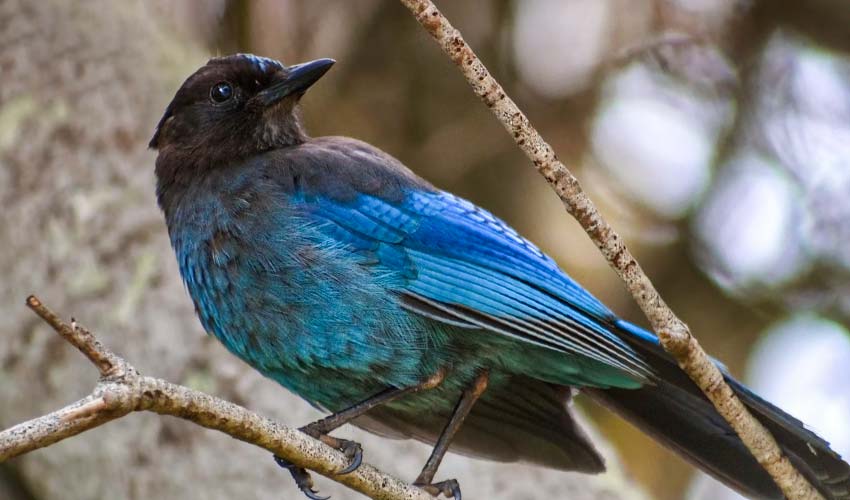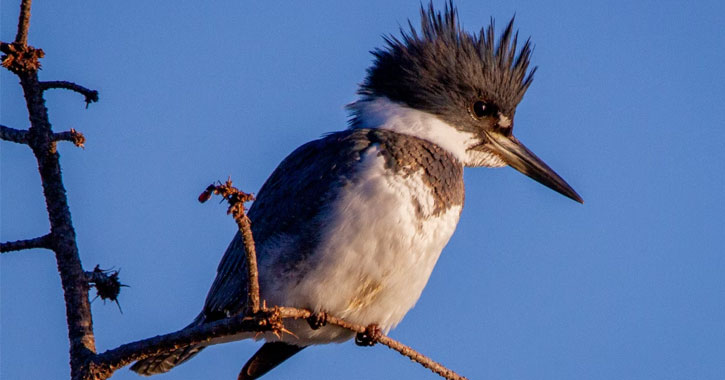There are 262 species of birds in Yosemite, representing about 45 families.
From falcons and eagles to adorable little hummingbirds and head-turning owls, there is an abundance of Yosemite birds to see at the park.
However, birdwatching isn’t that easy. You can’t just go to Yosemite and expect to see all 262 birds in one visit.
7 Must-See Birds in Yosemite (A Guide for Beginner Birding)
If you’re lucky, you’d be able to spot at least a couple from this list of must-see birds of Yosemite National Park.
1. Anna’s Hummingbird (Calypte anna)

- Places you might find Anna’s Hummingbird in Yosemite: Anna Hummingbirds frequents broken chaparral and woodland. During the breeding season, you’ll see them in the Upper Sonoran life zone, but spread out throughout the park when not breeding.
- Anna’s Hummingbird appearance: At 4 inches, Anna’s Hummingbird is the largest hummingbird in the region.
- Sound of Anna’s Hummingbird: The song of Anna’s Hummingbird is high-pitched, squeaky and repeated with a pulsating succession.
Anna’s Hummingbird is a medium-sized bird species from the Trochilidae family. It is native to western coastal regions of North America, now just breeding exclusively in California.
Male and female pairs only stay together just enough for them to mate. Anna’s Hummingbird eggs are extremely tiny – about the size of a jellybean.
Anna’s Hummingbirds feed on nectar from flowers, but they also eat small insects like spiders.
2. Bullocks Oriole (Icterus bullockii)

- Places you might find Bullocks Oriole in Yosemite: These bright-orange birds frequent streamside and oak woodland in the Lower Sonoran to the Transition life zone. You can find them on woodlands and hanging nests on cottonwood trees.
- Bullocks Oriole appearance: Male Bullock’s Oriole have orange belly, outer tail, forehead and lines on the face mixed with black tail, striped bill, and wing with patchy white spots. Females are gray with yellowish tail, breast and sides of the throat, but their plumage is mostly white.
- Sound of Bullocks Oriole: The song of a Bullock’s Oriole lasts about 2-3 seconds with a mix of rattling noises, whistling and scratching notes.
Bullock’s Oriole feed on insects (such as crickets,beetles, wasps, grasshoppers) hiding on shrubs and foliage of trees. Sometimes, these birds also catch flying insects or prefer nectar, berries, and other wild fruits.
Female Bullock’s Oriole looks very similar to the Baltimore Oriole females, which is the reason why hybrids occur. Both males and females are vocal birds, so if you are familiarized by their songs and calls, their sound can help you locate them.
3. Pileated Woodpecker (Dryocopus pileatus)

- Places you might find Pileated Woodpeckers in Yosemite: Pileated woodpeckers nest in big, decaying trees.
- Pileated Woodpeckers appearance: Mostly black plumage with striking white stripes across the face down to the body, and a bold red spikey “hair” called “malar stripe.” Females have a black stripe.
- Sound of Pileated Woodpeckers: As woodpeckers, the most obvious sound you can listen for is slow resonant drumming. Their calls are loud and are described as “clucking.”
Pileated woodpeckers are huge – almost the size of a crow. They are one of the biggest forest birds (and the largest woodpecker) in the country.
Pileated woodpeckers are pretty smart hunters. They use their long chisel-like bills to drill holes in rotting trees and wood in the forest, which then exposes hiding ants and other insects.
These dramatic three-colored woodpeckers are native to forests of North America. Their look is unmistakable, so if you’re lucky to spot one on your visit to Yosemite, it’s impossible to mistake them for any other bird.
Are you obssessed with woodpeckers as much as I am? If so, I’m sure you’d be interested in the Woodpeckers of Arkansas.
4. Ruby-crowned kinglet (Regulus calendula)

- Places you might find Ruby-crowned Kinglets in Yosemite: Ruby-crowned Kinglets are usually found on the floor of Yosemite Valley in the summer. They are regularly seen in the Hudsonian Zone, but not in the upper forest trees. Ruby-crowned Kinglets are common, but because they are quite a high-strung/anxious bird species, they are always on the move.
- Ruby-crowned Kinglets appearance: These small, olive green birds have a mix of gray and white streaks, a bright “ruby” on its crown and white wingbar. Females are identical to males, except they don’t have the ruby crown males are distinctively known for.
- Sound of Ruby-crowned Kinglets: Their song includes an accelerating series of high-pitched notes (about a dozen, loud “tsee” sounds) followed by low trills and a galloping noise.
Ruby-crowned Kinglets are described as high-energy birds, which are often seen frantically foraging through low trees and shrubs.
They feed on flies, ants, wasps, beetles, flies, small spiders and other insects, but have also been known to feed on poison ivy, elderberry, and tree sap.
These adorable “little king” birds rarely sit still, so it’s truly a birding achievement if you’re able to take a closer photo of a Ruby-crowned Kinglet.
However, this constant-movement is also the reason why they are easy to identify even to beginner birders.
5. Steller’s Jay (Cyanocitta stelleri)

- Places you might find Steller’s Jays in Yosemite: It is common to find Steller’s Jays in Yosemite campgrounds, picnic areas where they “ask” for food.
- Steller’s Jays appearance: It is easy to identify these blue birds – Steller’s Jays have a triangle-shaped head with dark brown and gray head, a black bill, and upper/lower chest and tail that looks blue. “Looks blue” because the blue is caused by structural coloration and not by the pigment coloration of the bird’s feathers.
- Sound of Steller’s Jays: Steller’s Jays have a loud, repeating squawking call, especially during aggressive interactions. They can growl and sometimes mimic the sound of other birds and mammals.
If someone asks you about the blue birds in Yosemite, they’re probably referring to the blue-feathered Steller’s Jays.
They’re the most common birds in Yosemite and have one of the most striking colors, too!
These birds are omnivores, feeding on 2/3 plants (like nuts, seeds, and fruits) and 1/3 animals (like snakes, lizards, small birds, and more). Steller’s jays also eat peanuts, cracked corn and seeds on feeders, especially during winter.
Like its famous Blue Jay family, Steller’s Jays are known to build their nests using mud.
They are very smart birds, mimicking all kinds of birds, chickens, dogs, cats, squirrels or even mechanical objects.
6. Northern Flicker (Colaptes auratus)

- Places you might find Northern Flickers in Yosemite: You can find Northern Flickers in any habitat around Yosemite with trees, but they avoid dense forests since they need to forage in open ground. They are often found by the Yosemite Valley and Yosemite West during mating season.
- Northern Flickers appearance: Northern Flickers are large woodpeckers with a spotted belly, black barring on the back, crescent-shaped black mark on the chest, yellow streaks on their tails, bluish bill and multi-colored head with a vibrant red mark on the head.
- Sound of Northern Flickers: Northern Flickers have a “wicka-wicka-wicka” call and loud rattling sound with a tone that rises and falls consecutively within a span of 6 to 8-seconds.
Northern Flickers do not look as dramatic as the Pileated Woodpeckers above, but these medium-sized birds also come from the woodpecker family.
Northern Flickers look majestic when they fly because they show off bright colors on their spread-out wings.
Northern Flickers are known to eat the most ants out of all birds in America.
They also feed on other insects like caterpillars, beetles, and termites year-round, but also eat fruits, seeds, nuts and berries during winter.
7. Belted Kingfisher (Megaceryle alcyon)

- Places you might find Belted Kingfishers in Yosemite: You can find Belted Kingfishers near rivers, lakes, ponds, streams, estuaries, and coastlines of Yosemite.
- Belted Kingfishers appearance: Belted Kingfishers are chubby birds with a large head and spikey “hair”, a shaggy crest on the chest, a straight pointed bill, beady black eyes, and short tail.
- Sound of Belted Kingfishers: Belted Kingfishers have a rattle-like call, especially when threatened.
Belted Kingfishers are awesome fishermen. They can plunge into the water with their heads first thanks to a special membrane that protects their eyes underwater.
These birds also fly low over water in search of prey, feeding mostly on small fish, crayfish, mollusks, moths, reptiles, and other insects and small amphibians.
During winter (and if they can’t hunt), they could eat berries.
Are there Endangered Birds in Yosemite?
Many birders aim to find the big guys – bald eagles and golden eagles, which are some of the most sought-after but rarest birds in Yosemite.
If you’re serious about birdwatching at this park, you should be updated with Yosemite National Park’s special status bird listings.
Here you’ll see that the Northern goshawk, bald and golden eagles, Peregrine falcon, Willow flycatcher, Yellow warbler, and owls like Great Gray, Long-eared and California spotted owls are all under special protection status.
Best Birdwatching Spots in Yosemite

If you’re new to birdwatching, wanting to find the best spot is alluring. After all, Yosemite covers an area of 759,620 acres, and that can’t be explored in just a day or two.
Planning is key when it comes to spotting these cool Yosemite birds. Fortunately, many people have gone before us and you can find expert birding trails and advice from the locals.
Know that each bird in Yosemite has its own preferred habitat – some like to nest near water, while others opt for high-altitude living. Other birds are social (even in the presence of humans), but most birds would be wary of people.
The song and call of a Yosemite bird can also help you distinguish them, even if you haven’t actually seen them.
You can also join birding tours from organizations like Bird Watching Academy, professional Birding instructors like Daniel Edelstein, or companies like Yosemite Adventure Collective, or you could plan your own birding tour yourself or with a group of like-minded friends.
Either way, I hope you enjoy the fantastic sights of Yosemite birds!
Want to see other cool-looking birds? Check out this list of purple birds around the world.
